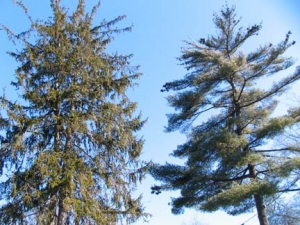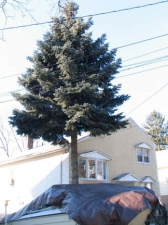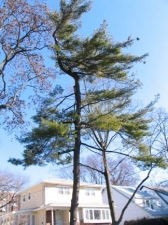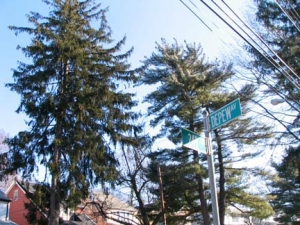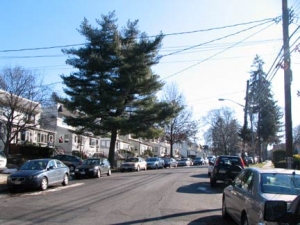The London plane tree, a variety of the sycamore, is the street tree of choice in New York — to the point of exhaustion, since street after street features so many of them. You’ll also find quite a number of oaks. Chestnut and elm, not so much; these have had their numbers cut into by disease over the years. The preponderance of London planes, as I’m sure you won’t be amazed by, is due to Parks Commissioner/transit czar Robert Moses’ love of them — he had them planted all over town beginning in the 1930s. The sycamore was also victim to attack by disease, and it was hybridded with the Oriental plane to make it hardier, producing the London plane.
Until around the turn of the century, most of the Little Neck area was sparsely populated, open farm land. In 1905, Mary and Benjamin Woolley sold a tract of land to the Rickert-Finlay Company which proceeded to lay out streets and building lots for the Westmoreland development. Generally, it is bounded by Northern Boulevard on the south, Little Neck Parkway on the west, the LIRR and 39th Road on the north and Nassau Road on the east. Most of the 300 or more homes in the area were built between 1905 and 1930. The title of every property in Westmoreland can be traced back to when Rickert-Finlay bought it. Westmoreland Association
At some time in the dim past, when curving 249th Street was laid out in Little Neck between 41st Avenue and Northern Boulevard near your webmaster’s home, someone decided the street would look just dandy with conifers of all varieties, and so, you’ll find dozens of them here, at the curb line and on home plots. In addition, there are a lot of conifers in my complex, Westmoreland Gardens. Quite the contrast to the usual London plane-dominated curbscapes. I will show you some of them on this page.
Eastern White Pine
Norway spruce, Eastern white pine, Colorado blue spruce
Some of the trees have odd shapes as they have been trimmed to avoid the power and utility lines, lessening the chance of combustion.
43rd Avenue and 249th until mid-2008 had an odd plant at the NW corner that I called the wishbone tree as it had a tuning fork-shaped trunk. Unfortunately it was cut down before I could get a picture. I’m told tres of that type frequently grow wishbone trunks.
To my eye conifer cones evolved to resemble insects or small animals like slugs, so that animals would snatch them and distibute the seeds. However I am also aware that conifers evolved long before larger land animals did, so I am likely wrong about that.
ForgottenFan Eric Weaver: The conifers I saw on your page are mostly Norway Spruces. The best way to identify conifers is by their cones. When I used to go hiking, my friends would be looking at the trees while I would be looking down at the cones. The cones you showed were Picea abies, the Norway spruce. If you bring one indoors for a few weeks, it will open up and spread the scales to drop seeds. The small seeds have wings that let them get blown by the wind for dispersal.
One of the other conifers is a Colorado Blue Spruce, a selected bluish clone of Picea pungens. The few pines in the pictures are best identified by number of needles (leaves) per bundle and the cones. There are 95 species of Pinus in the world with at least four only endemic to California.
Most conifer seeds have wings to disperse by wind. Rodents, like squirrels, will gnaw on the cones to get to the seeds hence some cones have curved hooks and prickles to protect the seeds. Some pine cones are covered with pitch which melts in a fire which lets the cone open to repopulate only after a fire.







